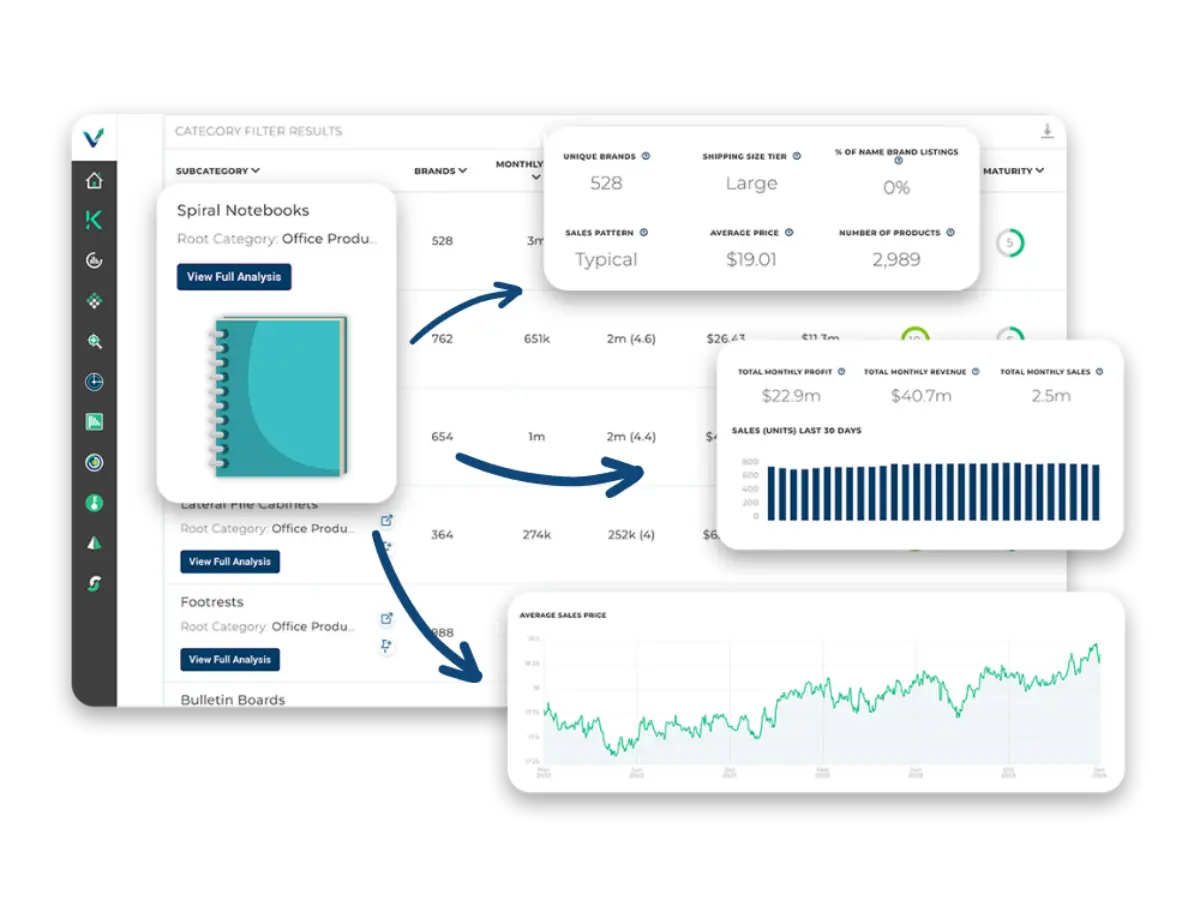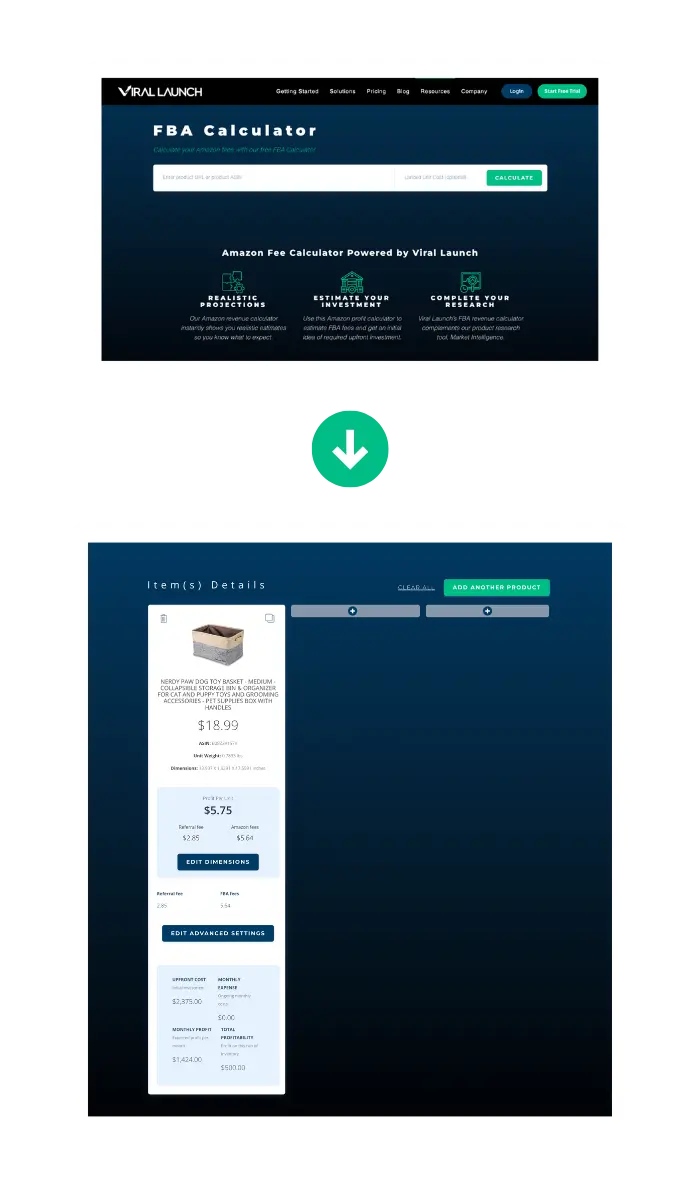Amazon has grown to be one of the largest retailers with 20 different international marketplaces and operates in over 100 countries. Given the retailer giant’s global presence and popularity, it’s no surprise that customers and independent sellers choose Amazon as their go-to channel when purchasing or selling products.
For many sellers, Amazon is a top choice when deciding which online retail platform to use due to a number of perks, most notably Amazon FBA (Fulfillment by Amazon). But what is Amazon FBA? Simply put, it’s a service that allows sellers to use Amazon’s warehouses and shipping services to automate their order fulfillment. When a customer orders a product through Amazon FBA, Amazon will handle the storage, packing, shipping, and customer service (including returns and refunds), making the logistics side of business a lot easier to handle for the seller. If you’re new to the seller space, feel free to check out our beginner’s guide to Amazon FBA.
Whether or not you’re new to the Amazon ecosystem, you might be wondering as a seller: is selling on Amazon worth it? After all, there is an increasing number of third-party sellers on the online retail platform. In fact, over 60% of sales in the Amazon store come from small-to-medium-sized independent businesses. While competition has certainly increased on Amazon and other platforms in recent years, the demand for online shopping hasn’t slowed down. By 2027, 23% of retail purchases are expected to take place online, and the e-commerce market is expected to generate over $7.9 trillion.
In this article, we’ll get into the details of whether selling on Amazon is still worth it in 2025 and beyond and provide additional seller insights on Amazon FBA.
Is Selling on Amazon FBA Worth It?
There’s always going to be a required cost to sell on e-commerce platforms like Amazon. As a business owner, it’s important to consider all your expenses before deciding the best route to proceed with. If you’re considering Amazon as one of your top choices, you may be thinking, “Is Amazon FBA worth it?” The short answer is yes.
Amazon has experienced immense growth over the past years and is expected to continue on this growth trajectory in the future. In 2022, the e-commerce giant generated a whopping $514 billion. Just one year, the company increased its revenue by 11.83% to $575 billion in 2023. In terms of market share, Amazon accounts for 37.6% of all e-commerce sales, the highest market share of all e-commerce companies.
As a seller, it’s also important to know that Amazon is estimated to have over 310 million active global users with the majority being based in the United States. Additionally, according to a study by Catalyst and Kantar, 63% of shoppers use Amazon for initial product research. If you’re thinking about setting up an Amazon FBA Business, this means you’ll have access to a sizable customer base which might benefit and inform your selling strategies.
Is Amazon FBA Oversaturated?
There’s no doubt that the Amazon marketplace has had increased competition over the past years. In fact, it’s estimated that there are nearly 10 million sellers on the platform, with more than 2 million actively selling in 2025. With such a high number of sellers, this means there’s a risk of the Amazon space being over saturated.
However, as we’ve mentioned before, the platform has an enormous user base in the United States and around the globe. With the right product and marketing approach, there are still plenty of opportunities for sellers to reach their intended audiences and increase their business’ growth potential.
How to Perform a Saturation Analysis
A saturated market poses numerous challenges for sellers trying to capture customers’ attention and reduce profit margins. However, knowing how to determine if certain Amazon markets are oversaturated can help sellers avoid those areas and plan business strategies for alternative markets. Below are some steps you can take when you’re performing a market saturation analysis:
- Calculate the market penetration rate: This is the ratio of the number of customers or users of a product to the total potential market size. For example, if there are 100 million users of video streaming services in a country with a population of 200 million people, the market penetration rate would be 50%. Higher market penetration rates indicate higher levels of market saturation, and vice versa.
- Calculate the market growth rate: This is the percent change in market size over a period of time. For example, if the video streaming service market grew from 100 million to 115 million users in one year, the market growth rate would be 15%. Higher market growth rates indicate lower levels of market saturation, and vice versa.
- Identify your competitors: Look at the number of businesses offering similar products. A high number of competitors can indicate a saturated market.
- Examine the market share distribution: Evaluate how the market share is distributed among competitors. If a few dominant contenders control the majority of the market, this could indicate a saturated market or a risk of one becoming oversaturated, leaving little room for new competitors.
- Calculate customer acquisition costs (CAC): This is the average cost a business needs to spend to acquire a customer. It’s calculated by dividing the total cost of sales and marketing by the number of customers acquired over a given period of time. For example, if a company spends $20,000 to acquire 1,000 customers, their CAC would be $20 per customer. If a CAC is consistently high, this may indicate a saturated market with limited growth potential.
- Keep up with industry and market trends: Stay informed about industry trends, market research data, and analyst reports that can provide insights into the level of saturation in your target markets.
Pros and Cons of Selling on Amazon FBA
With the risk of oversaturated markets, you might still be thinking, “Is selling on Amazon worth it?” For any business there are a number of risks to consider, but there are also many opportunities you can look for and capitalize on. We’ve compiled a comprehensive list of FBA pros and cons below that you can reference throughout your decision process.
Pros of Selling on Amazon
- FBA covers logistics for you: Amazon’s FBA program allows you to send your inventory to Amazon’s fulfillment centers, where they will handle any storage, packing, shipping, and customer service for you.
- Access to Amazon’s customer base: Amazon receives nearly 3 billion visits per month and has a loyal customer base of 230 million Prime members. Selling your products on Amazon means you’ll have access to a significant number of website visitors.
- Prime eligibility: Sellers that use FBA to fulfill their orders will have their products receive the Prime badge and gain access to Amazon Prime members who order exclusively from Prime sellers.
- Easy to launch products on Amazon: Selling on Amazon is relatively easy once you’ve set up your account. However, if you really want to be successful, you’ll need to plan for product listings, paid advertising, shipping, customer service, and brand registry (if applicable). If you’ve chosen to sell through Amazon’s FBA program, you won’t need to worry about some of these things like shipping and customer service. For more guidance on how to ship your inventory to Amazon FBA, be sure to check out our step-by-step guide.
- Growth Opportunities: As we mentioned in the beginning, Amazon has continuously generated high revenue numbers and currently holds the highest market share of all e-commerce platforms. The company’s growth trajectory is likely to continue in the future which means your business also has the opportunity to grow alongside it.
Cons of Selling on Amazon
- Storage Fees: While using Amazon’s FBA services eases some of the heavy weight off your shoulders, you’ll need to pay storage fees for storing your inventory in their fulfillment centers. There are two types of storage fees: monthly and aged. Learning how to optimize your inventory management will help you cut back on these costly fees and save your profit margins.
- FBA Fees: In exchange for using Amazon’s FBA services to help you fulfill orders (which includes storing, picking, packing, and shipping), you’ll need to pay FBA fees as well. These fees depend on the size and weight of your product.
- High Return Rates: Amazon has a rather generous return policy that makes it easier for customers to return items within a specified time period. However, this means sellers may experience high return rates for their products. Check out our guide for tips to reduce Amazon return rates.
- Competition: With nearly 10 million sellers worldwide, Amazon has become the main hub for sellers looking for potential customers. This means competition will be fierce, and if you’re in a saturated market or category, you’ll need to consider product differentiations and develop a good strategy.
- Limited Data: Amazon collects plenty of information about customers who visit its site. However, a lot of the data isn’t shared with sellers because Amazon considers these customers its own rather than yours. With such limited data, we recommend using a comprehensive tool like Viral Launch to help you track important metrics.
How Much Do Amazon Sellers Make?
Revenue and profits vary from seller to seller, but here are some statistics about how much they typically earn from selling on Amazon FBA:
| Monthly Sales | Percent of Sellers |
| $500 and under | 31% |
| $501 – $5,000 | 39% |
| $5,001 – $25,000 | 18% |
| $25,001 – $100,000 | 9% |
| $100,001 – $500,000 | 2% |
As you can see, the majority of sellers usually make under $5,000 a month in sales. This may not seem like a lot initially, but over time sales can accumulate with the right business strategy and proper planning.
Is Selling on Amazon Profitable?
Before launching into your potential business, another important question to consider as a new seller is, “Are Amazon stores profitable?” Generally speaking, Amazon FBA can be profitable since it allows sellers to outsource fulfillment tasks which saves them time and money as they scale their business. In fact, over 50% of sellers report being profitable within their first year, with 22% being profitable just within the first three months. As far as the Amazon FBA success rate goes, 46% of sellers experience a success rate of 11-25%.
A good strategy to promote success is to research the most profitable product categories and items to sell on Amazon. Knowing which product categories and items that are popular and in demand among customers will help give you a boost in business. If you’re looking for a tool to help you make these kinds of informative decisions, start with Viral Launch’s product discovery and market intelligence tools which can aid in product and market research and estimating sales potential to ensure profitability.

How Much Does it Cost to Start Selling on Amazon?
This depends from seller to seller because everyone has their own business goals and financial situations. Some sellers get their Amazon business up and running with just $500 or less while others have invested at least $10,000. However, we found that new sellers typically spend between $2,500 – $5,000 to jump start their business.
When setting up your business, you’ll need to consider essential Amazon business start-up costs including (but not limited to):
- Product samples
- Inventory
- Seller plans (individual vs. professional)
- Amazon fulfillment options (FBA vs. FBM)
- Unique product codes
- *Fees (referral fees, Amazon closing fees, rental book service fee, refund administration fee, high-volume listing fee)
- Marketing and advertising
- Registered trademark
- Professional photography and design
*Determining costs, sales, and revenue can be challenging with the number of fees you may need to pay. We recommend using a tool like Viral Launch’s free FBA calculator to help you get an idea of your projections and investments.

Check out our article for more details and information on how much it costs to sell on Amazon.
Final Thoughts: Is Selling on Amazon Still Worth It?
So, is selling on Amazon worth it? To answer shortly—yes. While there are costs and competition to account for, you can still enjoy the fruits of your labor with careful planning and budgeting. And as we mentioned before, Amazon’s FBA service does all the heavy lifting on the logistic side of things, making it a viable and profitable business model for all kinds of sellers.
To maximize profitability for your business, consider leveraging Viral Launch, which offers a range of seller tools for conducting market and competitor research. These tools help discover new product opportunities, optimize PPC ad campaigns, and manage keywords and listings. With these resources, you’ll have everything you need to be a successful FBA seller.








